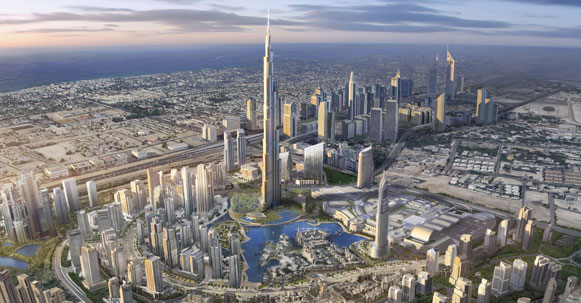Burj Dubai - now at 1,421 stories and 512.1 metres - is the tallest building in the world.
 Other News
Other News Subscribe to newsletter
Subscribe to newsletter
| 22 Jul 2007 |
Burj Dubai is now taller than Taipei 101 in Taiwan, which at 508 metres has held the tallest building in the world title since it opened in 2004. Burj Dubai has now reached 141 storeys - more storeys than any other building in the world.
On schedule for completion in 2008, Burj Dubai will be the tallest structure in the world in all four of the criteria listed by the Council on Tall Buildings and Urban Habitat (CTBUH). The council measures height to the structural top, the highest occupied floor, to the top of the roof, and to the tip of the spire, pinnacle, antenna, mast or flag pole.
During its construction, Burj Dubai has left behind the skyscrapers that previously defined tall tower architecture around the world, such as Petronas Towers in Malaysia at 452 metres; Sears Tower, Chicago at 442 metres; Jin Mao Building, Shanghai at 421 metres, and Empire State Building, New York at 381 metres.
The Burj Dubai story is only beginning. The final height and number of storeys, a topic of enthusiastic debate among media and experts alike, has not yet been revealed. But from now on, the tower will set new records for its technical and architectural ingenuity.

When completed, Burj Dubai will have consumed 330,000 cubic meters of concrete, 39,000 metric tons of steel rebar and 142,000 sqm of glass - and 22 million man hours. The tower will have 56 elevators travelling at 1.75 to 10 metres/sec and double-decker observatory elevators that can carry 42 people at a time.
More than 313,700 cubic metres of reinforced concrete and 62,200 tonnes of reinforcing steel have been used in the tower's construction so far. Burj Dubai has already set a new world record for vertical concrete pumping for a building by pumping to over 460 metres. The previous record of 448 metres was held by Taipei 101.
Reflecting a no-compromise approach to safety, Burj Dubai has been designed to manage the effect of wind and seismic movements. High-strength concrete makes up the tower's super-structure, which is supported by large reinforced concrete mats and piles. The 80,000 sq ft foundation slab and 50-metre deep piling are waterproofed and feature cathodic protection.
Burj Dubai became the tallest building in the world in just 1,276 days; excavation work started in January, 2004. More than 5,000 consultants and skilled construction workers are employed on site, and the world's fastest high-capacity construction hoists, with a speed of up to 2 m/sec - 120 metres/min, move men and materials.
Structural steel work for the tower will begin soon, and cladding work using a high-performance system has already started.
The primary cladding materials of reflective glazing, aluminium and textured stainless steel spandrel panels and vertical stainless tubular fins accentuate the tower's height and slenderness to the eye.




